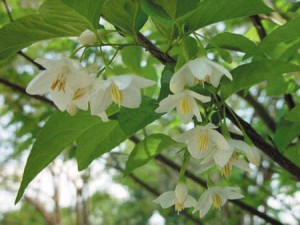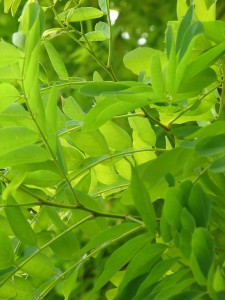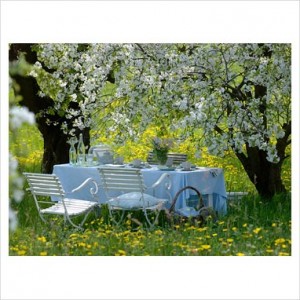Gazing Skywards – a fresh look at trees
There’s something magical about looking up through a leafy canopy. Dappled light adds a luminous quality to foliage, with such backlighting revealing details and colors which might otherwise go unnoticed. Several trees have wonderful downward facing flowers which are partially hidden by the surrounding leaves yet when viewed from below not only are they visible but there is an opportunity to appreciate their delicate beauty more intimately. And who can forget those childhood games of hide-and-seek behind a curtain of weeping willow as the swaying branches moved gently in the breeze?
Planning for such events is another way to add a layer not only of interest to the garden but an opportunity for interaction. There are two ways in which such garden moments can be orchestrated; by sitting or strolling beneath a tree or by looking upwards to a tree situated in an elevated position such as a hillside or raised bed. Here are just a few of my favorites.
The golden locust tree (Robinia pseudoacacia ‘Frisia’) has become my signature tree. Since moving to the United States in 1996 I have planted at least one in every garden. The primary role of these trees is to add a splash of light to the garden but I have also planted them in such a way that they either flank a pathway forming a golden allee through which to stroll, or to provide pleasant shade for a sunny patio. The sun always seems to be shining when you look up through the rustling golden canopy and never fails to make me smile. These are big trees, typically reaching 30’-40’ in height and 20-30’ in width so give it room to show off its beauty, although I do gradually limb mine up as needed both for shape and practicality. They are remarkably drought tolerant once established and take full sun or partial shade. The downside is that the branches have thorns although one rarely has a reason to touch them, and they tend to shed their leaves over a prolonged period of time. But what’s a few of minutes sweeping for the months of golden light they provide? Hardy in zones 3-8.

The delicate white flowers of the Japanese snowbell tree can only be appreciated fully from under neath the canopy. Photo credit; JC Raulston Arboretum, North Carolina State University
Japanese snowbell (Styrax japonica) is a perfectly behaved small tree yet is often overlooked. Early spring doesn’t suggest anything exceptional with attractive but otherwise fairly ordinary, mid-green leaves, although they do perch prettily atop the branches like little green butterflies. What makes this tree special are the fragrant white flowers which dangle downwards like hundreds of tiny bells in May and June. Set a bench underneath and sip your iced tree as you enjoy the delicate fragrance and marvel at such hidden treasures. Each bell has a tiny yellow ‘ringer’ which only adds to the enchantment. Japanese snowbell trees slowly grow to 15’ tall and wide and are hardy in zones 5-8. There are several cultivars and varieties which are worth seeking out including ‘Emerald pagoda’ which has larger, dark green leaves and more heavily textured flowers, and ‘Pink chimes’ – a popular, smaller specimen with pink flowers.
At this time of year cherry blossom trees are in full bloom with billowing clouds of pink and white adorning gardens and parklands across many countries. Washington DC received the gift of thousands of cherry trees in 1912 as a token of friendship from the people of Japan with this year celebrating their 100th anniversary.
The Tidal Basin in the Capitol is planted primarily with Yoshino cherries (Prunus x yedoensis) which create a magical journey beneath their extended branches while snowflake-like petals fall softly all around. Home gardens can create a similar romantic ambience with just a single specimen such as the well-known ‘Kwanzan’ cherry (Prunus serrulata ‘Kwanzan’) with its double flowers in deep pink or perhaps set a blanket under the broad spreading ‘Mt Fuji’ (Prunus serrulata ‘Mt. Fuji’) for a springtime picnic and enjoy the delicate confetti of petals. As with all cherry trees, do not plant these in close proximity to buildings or driveways as their strong root system can cause significant damage.
You have heard me say many times that I believe a garden should be experienced, not just observed, and that creating such ‘garden moments’ is to create memories which will last a lifetime. As springtime awakens our gardens and our spirits perhaps it is time to seek out the perfect tree which will remind you to pause and gaze skywards.



Locusts are among my favorite trees, though I've never grown one, let alone a golden one. I just love the quality of that wonderful, dappled shade. It's just dense enough to give relief from the sun without being so dark as to be buggy, even in northeastern humidity. You could actually sit in the shade on a hot summer day without being pestered by clouds of gnats and mosquitoes!
Stacy, you'd love this tree!
The golden locust is a gorgeous tree. I am waiting for a cultivar with purple flowers to be introduced. I have a very large Prunus yedoensis, and it is one of my favorite trees. Great fall color too.
Carolyn, wouldn't that be GORGEOUS!! Tell me if you ever come across one!
Karen and Stacy – Frisia locust is a favorite of mine, too. The filtered shade is nice for gardening beneath – not too dense. There IS a purple-flowered locust – Robinia pseudoacacia 'Purple Robe'. However, the leaves are green. Now if only we could combine the purple flowers with golden foliage . . .
Very nice article and suggestions Karen. Snowcone® Snowbell is worth a mention, too. It is a Schmidt introduction that we selected for narrow, upright form and refined foliage, and branches that don't suffer from twig dieback as is the case with some seedling-grown trees. Carillon is a weeping variety and there's a brand new weeping form called Fragrant Fountains that is even more lovely than Carillon.
Nancy, I had forgotten about 'Purple robe' but without those golden leaves it just doesn't grab me. It's that elusive golden foliage/purple blooms hybrid I want although perhaps growing a Niobe clematis through the Robinia would be fun.
Thanks for the information on the other Styrax. I especially love weeping trees and will watch for Fragrant Fountains.